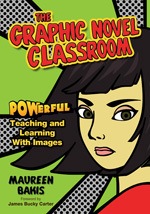Teaching with Graphic Novels
The Graphic Novel Classroom: Powerful Teaching and Learning with Images
by Maureen Bakis
(Corwin Press, 2012 – Learn more)
You have to admire a teacher like Maureen Bakis, who took the leap to transform one of her high school English elective classrooms into a graphic novel-oriented literacy environment. It’s evident from emerging literature that more and more teachers are starting to dabble with the graphic arts as part of an ever-expanding notion of literacy. But Bakis’ move to completely create an environment for her high school students that not only uses graphic novels for literature, but also taps into the same field to for inspiring composition and art/media studies, is audacious and intriguing to consider.
In The Graphic Novel Classroom, Bakis brings us right into her classroom at Masconomet Regional High School in Massachusetts. While the chapters in the book are nicely situated around themes of social justice, conceptions of heroes, racial and gender identity, and connections to classic literature, what I found the most useful were the reflective writing and comics from her students as they explored the relatively unknown terrain of graphic arts. The students’ reflections, in particular, really unpack how much learning was going on in this fairly untraditional setting.

Along with the McCloud text, Bakis has wisely chosen books and comics from what might be considered some of the best of the modern graphic novel canon: Maus by Art Spiegelman, American Born Chinese by Gene Leun Yang, A Contract with God by Will Eisner, Persepolis by Marjane Satrapi, V for Vendetta by Alan Moore, and Batman: The Dark Knight by Frank Miller. She does not leave off traditional literature, either, but couples novels of importance to graphic novels of importance. So, along with Maus, her students are reading Night by Elie Wiesel; along with V for Vendetta, she introduces Plato’s Allegory of the Cave.
Too many educational studies in recent years have focused almost solely on the reading of graphic novels, and not as much on the composing of graphic stories. Bakis does not make this mistake. She shows how the teaching of graphic novels can open doors for student expression in interesting ways that couple story with art, and she provides numerous examples of that student work in this book, sharing both the actual assignments and the pedagogy behind them.
They will read this
All in all, The Graphic Novel Classroom provides a clear path for teachers curious about the allure and power of the graphic story for student readers and writers. While the classroom here is a high school setting, a reader could easily adapt and revamp the teaching techniques with other graphic novels. Bakis begins her preface with the question that vexes many of us: “Why won’t they read?” And what teacher of any level isn’t asking themselves the same question these days?
While the classroom here is a high school setting, a reader could easily adapt and revamp the teaching techniques with other graphic novels.
I remember the first time I understood the potential of the comic. My oldest son and I wandered into our local comic book store during an annual event called 24 Hour Comic (goal: create a 24 panel comic in 24 hours). My middle-school-aged son was deep into the Bone series, by Jeff Smith, and had begun to create his own line of comics. We went to the store, just to see what this 24 Hour Comic event was all about. I was amazed to find the store packed with kids of all ages, sprawled out in every possible space, quietly focused on creating art-infused stories. They were writing. They were reading. They were sharing, editing, revising. And there was not a teacher in sight (other than me, and I was hiding behind my own graphic story that I was writing that day.) It was fascinating to be in the midst of that creative energy.
From that day on, I started to see the potential of graphic novels and creating comics as an authentic learning experience in my sixth grade classroom, where my students make webcomics on a variety of topics and read graphic novels (such as The Odyssey) as part of literature studies. The Graphic Novel Classroom provides us with even more evidence that there is complex thinking and rigorous reading going on when a kid cracks open a graphic novel and digs in.
Kevin Hodgson is a sixth grade teacher in Southampton, Massachusetts, and is the technology liaison with the Western Massachusetts Writing Project. He is a regular contributor to The Graphic Classroom book review website and The Nerdy Book Club website. Kevin has run summer camps for middle school students around webcomics, and he uses comics and graphic novels for reading and writing with his sixth graders. He also dabbles in comics, himself, including a two-year publishing stint for The Springfield Republican newspaper with Boolean Squared, which aimed to be a humorous look at the digital divide between teachers and students. Kevin blogs regularly at Kevin’s Meandering Mind and tweets more often than is healthy under his @dogtrax handle.





































Kevin,
Thanks for such a glowing review! You really see what I see—comics as a powerful medium for teaching literacy!
Maureen